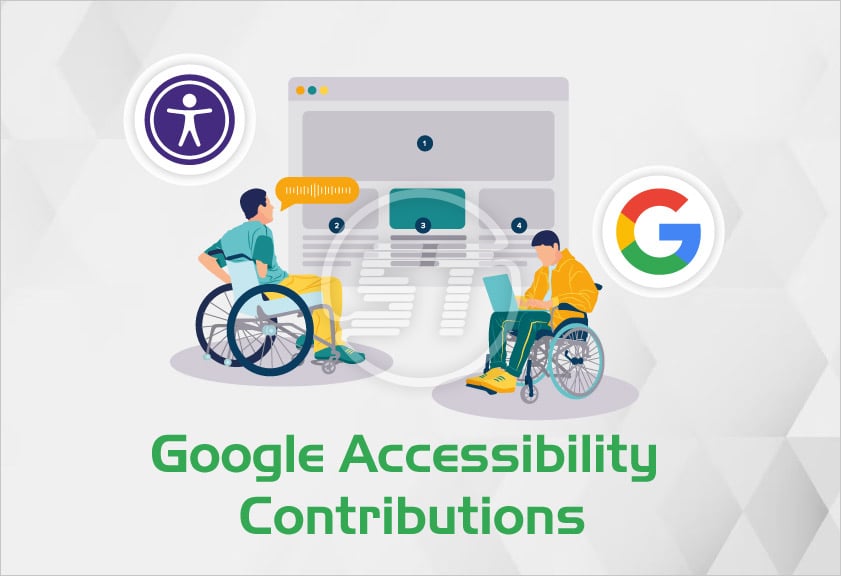Google has made significant futuristic contributions to digital accessibility. The company’s commitment to accessibility can be seen in its efforts to ensure that digital content is accessible to everyone, including people with disabilities. By combining technical innovations, active participation in standards bodies, a focus on inclusive design, and a strong educational push, Google is helping to build an accessible web.
As the web continues to evolve, Google’s contributions will likely continue to influence how accessibility is defined, implemented, and standardized across digital platforms.
Let’s understand it in detail.
Some noteworthy contributions by Google that are influencing web standards!
Development of accessibility tools and libraries
- ARIA (Accessible Rich Internet Applications) support: Google has been a strong proponent of ARIA, a set of attributes that define ways to make web content and applications more accessible to people with disabilities. ARIA roles, properties, and states help improve the accessibility of complex web applications, and Google’s tools like Chrome DevTools provide ARIA debugging features. Explore more about ARIA web accessibility .
- Accessibility developer tools: Tools like Lighthouse Accessibility Audit and Accessibility Insights are developed by Google to help developers identify and fix accessibility issues in their web applications.
Improving screen readers and browser accessibility
- ChromeVox screen reader: Google’s ChromeVox is a screen reader designed for visually impaired users, built specifically for Chrome and Chrome OS. It is an open-source and has set a standard for how browsers should handle accessibility features.
- Accessibility in Chrome: Chrome’s accessibility features have been continuously updated to support evolving web standards. Chrome has implemented features like text scaling, keyboard navigation, and screen reader support that are aligned with the latest accessibility guidelines.
Contributing to W3C standards and initiatives
- Active participation in W3C: Google is an active participant in the World Wide Web Consortium (W3C), which develops international standards for the web. They contribute to the Web Accessibility Initiative (WAI), which defines guidelines such as WCAG (Web Content Accessibility Guidelines). Google’s input is crucial in shaping these guidelines to cover new web technologies.
- Accessible Rich Internet Applications (ARIA) Working Group: Google is involved in the ARIA working group, helping to refine ARIA standards and their integration into web platforms and applications.
Promoting inclusive design practices
- Material design accessibility guidelines: Google’s material design includes accessibility guidelines to help developers create accessible apps and websites by default. These guidelines cover contrast ratios, scalable typography, and interactive elements that are easy to use with screen readers.
- Inclusive design research: Google invests in research on inclusive design, contributing to the broader conversation about accessibility. This includes studies on the needs of people with disabilities and the development of new patterns and components that accommodate a wide range of users.
Innovating with AI and Machine Learning
- AI-powered accessibility features: Google has integrated AI-powered features like Live captions (which provide real-time captions for videos) and Lookout (an app for people with visual impairments) into its products. These innovations are influencing how future web standards can leverage AI to improve accessibility.
- Auto-generated alt text: Google’s use of machine learning to generate alt text for images is a step toward a more accessible web where visual content becomes understandable for screen reader users.
Developer education and resources
- Web.dev and accessibility resources: Google’s web.dev platform offers extensive resources and tutorials on building accessible websites. These resources help developers understand accessibility best practices and stay updated on the latest web standards.
- Conferences and advocacy: Google frequently advocates for accessibility at major conferences (such as Google I/O) and through partnerships with other tech giants to promote inclusive web practices.
Open-sources accessibility projects
Google has open-sourced many accessibility projects that provide developers with the tools and frameworks needed to create accessible web applications. This includes libraries, test suites, and educational materials.
Cross-platform accessibility initiatives
While not strictly web-related, Google’s work on Android’s accessibility features influences web standards, particularly as the lines between web apps and native apps blur.
More accessibility features in all Google products
Google regularly integrates accessibility features into its products to update them as per the latest accessibility requirements. For instance, Google Assistant now recognizes sign language and Google Maps provides detailed information about wheelchair accessibility, etc.
- Google’s core updates are another addition to their valuable contribution to web accessibility. The core and useful updates are all about content quality and relevancy, which is a requirement behind accessibility.
- Google’s core web vitals and E-A-T (expertise, authoritativeness, and trustworthiness) are also enhancing the overall quality of digital content and helping people to get genuine results.
In a nutshell,
Google’s contributions to accessibility not only impact their own products but also set standards that help to shape the future of the web to be more inclusive and accessible for everyone. The company is focusing on creating more accessible spaces for people with disabilities. And thus, implementing innovative ideas to ensure digital inclusion!


